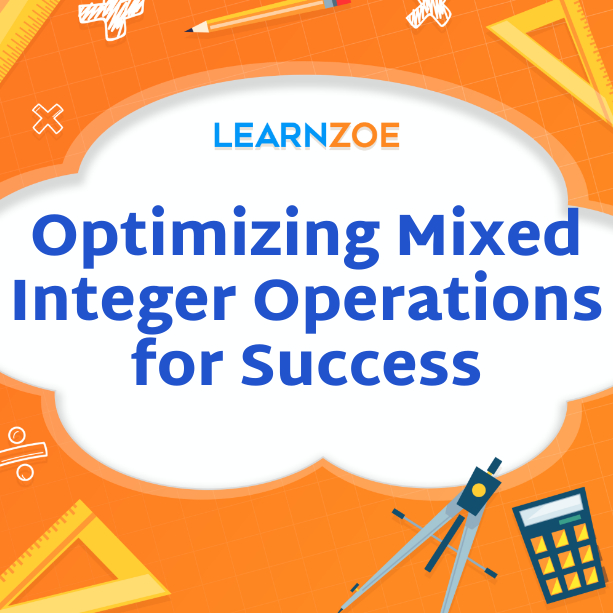Optimizing Mixed Integer Operations for Success

Understanding Mixed Integer Operations
Mixed Integer Programming is a powerful tool for optimizing integer and non-integer decision variables, making it suitable for many practical applications. By understanding the types of integer programming, such as 0-1 integer programming, one can effectively select the appropriate solving method and apply it to real-world scenarios. While there are challenges in solving integer programming problems due to integer constraints, they offer higher accuracy and practicality in modeling and solving complex issues. Whether optimizing supply chains or selecting portfolios, mixed integer operations provide the means to make informed decisions that can lead to success.
Importance of mixed integer operations in optimization
Mixed integer operations are crucial in optimization, allowing for more accurate and practical decision-making in various fields. By incorporating integer and non-integer decision variables, mixed integer programming provides a comprehensive approach to problem-solving. It is particularly important in scenarios like supply chain optimization or portfolio selection, where the inclusion of integer constraints helps model real-world constraints more effectively. Despite the challenges involved in solving integer programming problems, such as determining the optimal solutions within the given constraints, mixed integer operations offer significant benefits in terms of accuracy and feasibility. With its ability to handle discrete and continuous variables, mixed integer operations are a powerful tool for optimizing complex systems and maximizing success.
Challenges faced in mixed integer operations
Challenges faced in mixed integer operations include the complexity of finding optimal solutions within the given constraints. Including integer variables adds a layer of difficulty to the optimization process, as it requires searching through a larger solution space. It can increase computational time and make the problem more difficult to solve. Additionally, integer constraints can lead to non-convexity in the optimization problem, further complicating the solution process. Balancing the trade-off between accuracy and computational efficiency is another challenge in mixed integer operations, as finding an exact solution may be computationally expensive. However, advancements in algorithms and optimization techniques have helped address these challenges and improve the efficiency and effectiveness of mixed integer operations.
Techniques for Optimizing Mixed Integer Operations
Linear programming is a powerful technique for optimizing mixed integer operations, as it allows for the simultaneous handling of integer and non-integer decision variables. By formulating the problem as a linear program, we can leverage efficient algorithms to find optimal solutions within the given constraints. Additionally, integer programming methods provide specialized techniques for optimizing mixed integer operations. These methods involve incorporating specific constraints and objective functions tailored to the problem. Considering the discrete nature of the integer variables, these methods can effectively guide the search for optimal solutions. These techniques optimize mixed integer operations and improve decision-making in various real-world applications.
Linear programming for mixed integer operations
Linear programming is a powerful technique for optimizing mixed integer operations by formulating the problem as a linear program. It allows for the simultaneous handling of both integer and non-integer decision variables. Linear programming can find optimal solutions within constraints by leveraging efficient algorithms. Additionally, integer programming methods provide specialized techniques for optimizing mixed integer operations by incorporating specific constraints and objective functions tailored to the problem. These methods consider the discrete nature of integer variables and guide the search for optimal solutions more effectively. These techniques optimize mixed integer operations and improve decision-making in various real-world applications.
Integer programming methods for optimization
Integer programming methods are effective techniques for optimizing mixed integer operations. These methods specifically address the discrete nature of integer variables and guide the search for optimal solutions. One commonly used approach is branch and bound, which systematically explores different feasible solutions by branching on integer variables and bounding the search space. Another technique is cutting planes, which adds additional constraints to eliminate infeasible solutions and tighten the relaxation of the problem. Additionally, advanced algorithms such as dynamic programming and column generation can be employed to solve large-scale mixed integer problems efficiently. By leveraging these methods, practitioners can improve the efficiency and accuracy of their optimization models, leading to better decision-making in various real-world applications.
Conclusion
To conclude, optimizing mixed integer operations is essential for achieving success in various industries. Organizations can drive efficiency, profitability, and innovation by leveraging the power of mixed integer programming (MIP). As explored in this article, sensitivity analysis is crucial in decision-making processes and offers valuable insights into optimizing MIP models. Practitioners can harness its full potential by understanding the fundamentals of MIP, exploring its applications, and implementing best practices. Looking to the future, advancements in MIP techniques hold great promise for further enhancing optimization efforts. By staying informed about these trends and embracing new approaches, organizations can continue to optimize their mixed integer operations and stay ahead in an ever-evolving technological landscape.
Future trends and advancements in mixed integer optimization techniques
Future trends and advancements in mixed integer optimization techniques are poised to revolutionize the field. One key area of focus is the development of algorithms that can efficiently solve large-scale mixed integer programs. Researchers are exploring new approaches, such as decomposition methods and parallel computing, to tackle these complex problems. Additionally, there is a growing interest in incorporating machine learning techniques into mixed integer optimization models to improve solution quality and speed. Another promising trend is integrating uncertainty management methods, such as stochastic programming and robust optimization, to handle real-world scenarios with uncertain parameters. As technology advances, we can expect further innovations in mixed integer optimization, ultimately leading to more effective and efficient solutions for various industries.
